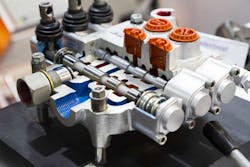There is a growing trend in the hydraulics industry toward the development of more compact components and systems. This trend is being driven by several factors, including a need to be more efficient and reduce space claim on vehicles and machines.
“There are tons of reasons why systems are getting more compact. It is not just one [reason]; it is different things for different end customers,” said Cindy Cookson, Vice President, Global Product Line Management – Industrial Fluid Power at Gates Corp., during the National Fluid Power Association’s (NFPA) Fluid Power Industrial Consortium (FPIC) quarterly seminar on compact hydraulic systems held in September 2023.
Cookson said there is a technological evolution taking place in the fluid power industry, as well as cultural and societal factors and channel drivers – such as efforts to reduce emissions and evolving customer design priorities – which are all contributing to the creation of more compact hydraulic system designs.
Why are Compact Hydraulics Growing in Use?
According to Cookson, trends related to productivity, logistics and ESG (environmental, social and governance) are among the key aspects driving the fluid power industry’s technological evolution and development of more compact hydraulic systems.
On the productivity side of things, she said there is a lot of effort being made to reduce weight, particularly in the mobile hydraulics sector which can be achieved through more compact component and system designs. This is especially important for agricultural equipment because of the need to reduce soil compaction to ensure crops are not damaged, which could negatively impact a farmer’s business. Weight reductions can also benefit fuel economy, leading to reduced fuel and thus operational costs for machine owners.
The replacement of manual labor in many industries with machines is also a driving factor, said Cookson. When thinking of places where a human may work, oftentimes the machine replacing that person will need to be equally sized which requires use of compact hydraulic systems to create a compactly sized machine as well.
In terms of logistics, ever-increasing urbanization is a key driving factor for the creation of more compact hydraulic systems. “As urbanization continues around the globe, we need equipment that can operate in tight spaces in urban environments,” said Cookson. “And furthermore, as we rebuild our urban environments, you have to be able to retrofit and fit in between buildings or maybe fit in the basement of a building. You need compact equipment to do that,” which necessitates use of compact hydraulic systems.
Freight costs are a driving factor as well for both OEMs and their end-use customers. Shipping costs can be reduced with compact systems because they are lighter in weight – reducing costs of shipping the system itself as well as the machine into which it is integrated. The machine itself can also be more compact and lighter in weight, benefiting cost reductions.
Potentially even more compelling, said Cookson, are the benefits to end users who want to put a machine on a standard piece of hauling equipment, such as a trailer, without having to get a special license or permit. This can be achieved when machines are more compact in size, which again is possible with compact hydraulic systems.
When it comes to ESG, compact hydraulic systems can provide an array of benefits as well. Whether it is reducing fuel use or emissions, minimizing how much material is used or other aspects, Cookson said compact systems can contribute to achieving all of those goals.
Bigger Hydraulic Systems are Not Always Better
When developing hydraulic systems, Cookson noted it is important to remember that bigger does not always mean better. In many cases, a more compactly sized system has the ability to provide the same performance as a larger system but with additional benefits possible such as weight reduction.
She said the fluid power industry needs to push to do more in smaller spaces. “This means we need improved system efficiencies and more accessibility in tight spaces,” she said. These can help achieve the increased power density requirements many in the industry are seeking.
Because space claim is becoming a greater concern in mobile applications, the ability to create compact systems capable of providing the same or better performance as larger systems will become more critical for those in the hydraulics industry.
As an example, Cookson noted how in the automotive sector there are insurance premiums in some regions related to the clearance around critical system components. She explained that in many cases, the more clearance there is around the engine compartment, the lower an insurance premium will be. Therefore, many OEMs are looking for ways to reduce the size of their engine compartment without having to make major changes to their vehicle platform – making way for other changes such as reducing the size of a vehicle’s various components and systems.
READ MORE: A New Approach to Hydraulic Reservoir Designs
Increased development of alternative power systems is also requiring the industry to reconsider the size of hydraulic components. Battery-electric systems, for instance, tend to take up more space due in large part to the size of the batteries, necessitating other systems become more compact. Doing so helps to offset the added weight of the batteries as well.
As no technology can yet overcome the power density of hydraulic systems, particularly in larger, heavier duty machines, hydraulics will still play a key role even as alternative power systems become more common. Cookson noted that in hybrid machines, there are actually more hydraulics used.
But to achieve the efficiencies desired in hybrid- and full-electric designs, it will be necessary to rethink hydraulic system architectures – which includes size considerations.
Technology Advancements Enabling Compact System Designs
Cookson said there are various technologies enabling the creation of compact hydraulic systems. Among these are advanced materials which have entered the market as well as innovative manufacturing processes.
READ MORE: Lightweight Hydraulics Offer New Opportunities to Manufacturers
Similarly, there are a variety of design methods which can be used to create compact hydraulic systems. During Cookson’s FPIC presentation, the potential of hose bend radius and flow velocity capability improvements as a means of downsizing hydraulic circuits were mentioned.
She said there is a lot of research currently being conducted in this area, among others, to help enable the design of more compact systems. In terms of increasing flow, Cookson said there are opportunities to do so with some of the new materials that are entering the market.
In general, though, it is important to understand the performance characteristics you’re trying to achieve with your system design, various industry standards as well as ensuring the hose and other parts of the hydraulic system can fit within the installation space.
She explained that hoses are often the last component designed into a compact system, so there’s often not a lot of space to route the hoses. “As the hose itself can get more compact without the inner diameter getting smaller, so you have smaller wall thicknesses, that offers a lot of value to customers because you can just physically fit the hose in the space,” she said.
A greater integration of electronics with hydraulics is also enabling the creation of compact hydraulic systems. For motion control solutions, this pairing of electrical and mechanical can come in the forms of electromechanical, electrohydraulic or electrohydrostatic actuation explained David Geiger, Engineering Manager at Moog Inc., during the FPIC quarterly seminar.
While each has its pros and cons, Geiger said electrohydrostatic actuation systems (EAS) bring together the best of both worlds, meeting many of the criteria which designers are looking for:
- energy efficiency
- environmental cleanliness
- low noise emission
- high forces
- no backlash.
EAS typically combines an electric motor, sometimes comprised of a servo drive and servo motor, with a hydraulic transmission – often a combination of a radial piston pump, manifold and hydraulic cylinder. Geiger explained that with EAS, you have a prime mover, such as a servo motor or any bi-directional motor, running a bi-directional pump to generate force and motion.
This technology is a key part of the company’s Electrohydrostatic Pump System (EPS) which offers customers the ability to use their existing hydraulic cylinder technology. It is comprised of a standardized manifold with hydraulic accumulator and Moog’s Electrohydrostatic Pump Unit (EPU) which is a compact device that enables creation of a decentralized system, eliminating the need for a hydraulic power unit and complex piping which allows space claim within a machine to be reduced.
Creation of compact systems was one of the key areas outlined in the NFPA’s 2023 Technology Roadmap as a way for the fluid power industry to help meet various customer requirements, particularly in the areas of increased productivity and performance and lower total cost of ownership. To do so, the roadmap notes systems should not only be smaller in weight and size, but also able to provide increased energy efficiency and power density.
As the examples above demonstrate, development of new components and system architectures – alongside other technology advancements – will help to enable the creation of more compact hydraulic systems and the fluid power industry to achieve its future design goals.
About the Author
Sara Jensen
Executive Editor, Power & Motion
Sara Jensen is executive editor of Power & Motion, directing expanded coverage into the modern fluid power space, as well as mechatronic and smart technologies. She has over 15 years of publishing experience. Prior to Power & Motion she spent 11 years with a trade publication for engineers of heavy-duty equipment, the last 3 of which were as the editor and brand lead. Over the course of her time in the B2B industry, Sara has gained an extensive knowledge of various heavy-duty equipment industries — including construction, agriculture, mining and on-road trucks —along with the systems and market trends which impact them such as fluid power and electronic motion control technologies.
You can follow Sara and Power & Motion via the following social media handles:
X (formerly Twitter): @TechnlgyEditor and @PowerMotionTech
LinkedIn: @SaraJensen and @Power&Motion
Facebook: @PowerMotionTech

Leaders relevant to this article:





